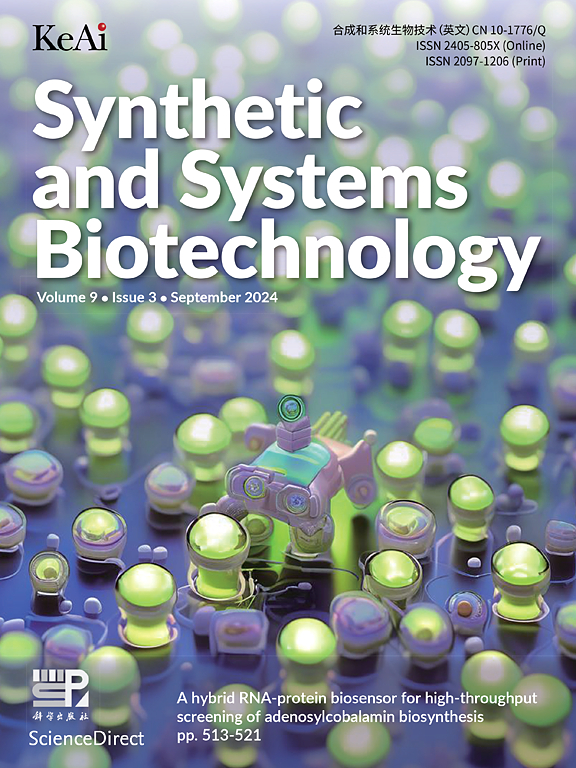设计细胞色素P450以提高酿酒酵母菌中孤雌醇内酯的产量
IF 4.4
2区 生物学
Q1 BIOTECHNOLOGY & APPLIED MICROBIOLOGY
引用次数: 0
摘要
Parthenolide被证实是抗癌药物act001的重要成分。然而,酿酒酵母(S. cerevisiae)的前体木香内酯的低转化率极大地阻碍了parthenolide的生物合成。本研究采用位置特异性评分矩阵(PSSM)对parthenium Tanacetum parthenium (TpPTS) parthenolide synthase的序列进化信息进行分析,设计并验证了一系列突变体。值得注意的是,当TpPTS - y22g突变体引入酵母时,与TpPTS野生型相比,parthenolide滴度提高了110%。考虑到TpPTS作为内质网定位的细胞色素P450和血红素供应的重要性,在酿酒酵母中过量表达内质相关分子伴侣HRD1(羟甲基戊二酰辅酶A还原酶降解蛋白1)和血红素生物合成基因HEM2(氨基乙酰酸脱水酶),以提高TpPTS的表达和催化活性。结果,在摇瓶中获得了27.08 mg/L的效价,进一步提高了209%。此外,与初始菌株yYTQ001相比,寇斯图内酯转化为parthenolide的转化率从20.4%提高到51.8%。最终,在一个5-L的生物反应器中,parthenolide滴度达到99.71 mg/L。本研究为设计限速细胞色素P450酶提高酿酒酵母倍半萜的产量提供了有效的策略和有价值的参考。本文章由计算机程序翻译,如有差异,请以英文原文为准。

Engineering the cytochrome P450 to enhance parthenolide production in Saccharomyces cerevisiae
Parthenolide is confirmed to be an important component of the anticancer drug—ACT001. However, parthenolide biosynthesis in Saccharomyces cerevisiae (S. cerevisiae) was greatly hindered by the low conversion rate of its precursor, costunolide. In this study, the Position Specific Scoring Matrix (PSSM) was used to analyze the sequence evolutionary information of parthenolide synthase from Tanacetum parthenium (TpPTS), and a series of mutants were designed and validated. Notably, when the mutant of TpPTS—Y22G was introduced in S. cerevisiae, the parthenolide titer increased by 110 % compared to that of the TpPTS wild-type. Considering TpPTS as an endoplasmic reticulum-localized cytochrome P450 and the importance of heme supply, endoplasmic-associated molecular chaperone HRD1 (hydroxymethyl glutaryl-coenzyme A reductase degradation protein 1) and heme biosynthesis gene HEM2 (aminolevulinate dehydratase) were overexpressed in S. cerevisiae to improve TpPTS expression and catalytic activity. As a result, a titer of 27.08 mg/L parthenolide was achieved in a shake flask, which was further increased by 209 %. Additionally, the conversion rate of costunolide to parthenolide increased from 20.4 % to 51.8 % compared to the initial strain yYTQ001. Eventually, a parthenolide titer of 99.71 mg/L was achieved in a 5-L bioreactor. Our research provides effective strategies and valuable references for engineering rate-limiting cytochrome P450 enzymes to improve sesquiterpenes production in S. cerevisiae.
求助全文
通过发布文献求助,成功后即可免费获取论文全文。
去求助
来源期刊

Synthetic and Systems Biotechnology
BIOTECHNOLOGY & APPLIED MICROBIOLOGY-
CiteScore
6.90
自引率
12.50%
发文量
90
审稿时长
67 days
期刊介绍:
Synthetic and Systems Biotechnology aims to promote the communication of original research in synthetic and systems biology, with strong emphasis on applications towards biotechnology. This journal is a quarterly peer-reviewed journal led by Editor-in-Chief Lixin Zhang. The journal publishes high-quality research; focusing on integrative approaches to enable the understanding and design of biological systems, and research to develop the application of systems and synthetic biology to natural systems. This journal will publish Articles, Short notes, Methods, Mini Reviews, Commentary and Conference reviews.
 求助内容:
求助内容: 应助结果提醒方式:
应助结果提醒方式:


